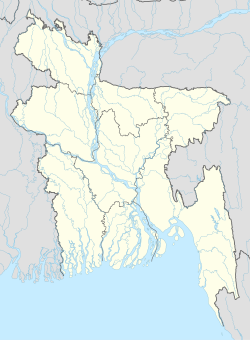
Back سلهت Arabic سيلهيت ARZ চিলেট Assamese Silhet Azerbaijani Сілхет Byelorussian সিলেট Bengali/Bangla সিলেট BPY Sylhet Catalan Sylhet (kapital sa lalawigan) CEB Silét (město) Czech
This article needs additional citations for verification. (May 2024) |
Sylhet (Bengali: সিলেট; IPA: [sileʈ]) is a metropolitan city in the north eastern region of Bangladesh. It serves as the administrative center for both the Sylhet District and the Sylhet Division. The city is situated on the banks of the Surma River and, as of 2025, the metro area population of Sylhet is estimated to be 1,033,000, reflecting a 3.4% increase from 2024.[5] This makes it the third-largest urban area in Bangladesh.
Sylhet is known for its tea plantations and natural scenery.[6] The region has been inhabited since ancient times, and since the city's establishment in the 14th century has been ruled by various dynasties including the Mughals, the British, and the Nawabs of Bengal. The city is also home to several important landmarks, such as one of the Islamic sites in Bangladesh, the Shah Jalal Dargah, which attracts thousands of pilgrims annually.[7] Sylhet is also the first city in the country to have a road with no overhead cable.[8]
Sylhet is one of the most economically important cities in Bangladesh after Dhaka and Chittagong.[9] A major commercial and financial center, Sylhet is home to several multinational companies and industries, including the tea industry, which generates a significant amount of revenue for the city. Sylhet has diverse transport infrastructure, with a modern airport, railway station, and bus terminals that connect it to other parts of the country.[10] The city also has several educational institutions, including Sylhet Agricultural University, Shahjalal University of Science and Technology and Sylhet Cadet College.
- ^ "Bangladesh clamps down on beggars". BBC News. 2 April 2009. Retrieved 2 April 2009.
- ^ Population and Housing Census 2022 - District Report: Sylhet (PDF). District Series. Dhaka: Bangladesh Bureau of Statistics. June 2024. ISBN 978-984-475-284-9.
- ^ "Sub-national HDI – Area Database – Global Data Lab". hdi.globaldatalab.org. Retrieved 11 July 2025.
- ^ "বাংলাদেশ পরিসংখ্যান ব্যুরো".
- ^ "Sylhet, Bangladesh Metro Area Population 1950-2025 | MacroTrends". www.macrotrends.net. Retrieved 9 June 2025.
- ^ "The Most Beautiful Tea Gardens in Bangladesh to visit". United News of Bangladesh. Retrieved 5 March 2023.
- ^ Chowdhury, Aisha Hayder (25 February 2021). "Sylhet in Spirit". The Daily Star. Retrieved 5 March 2023.
- ^ "No more cobweb of cables!". The Daily Star. 9 January 2020. Retrieved 21 January 2025.
- ^ Martin, Megan (17 October 2022). "Discover the 9 Largest Cities In Bangladesh". AZ Animals. Retrieved 5 March 2023.
- ^ "No more cobweb of cables!". The Daily Star. 9 January 2020. Retrieved 5 March 2023.





